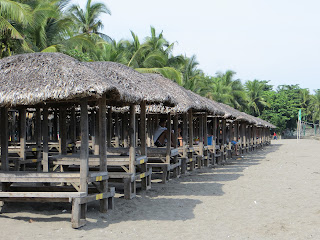My first three months in the Philippines are devoted to Pre-Service Training (PST).
During this time, all the Peace Corps trainees undergo training at
various locations before being sworn in as official volunteers in
September. Before then, I am Peace Corps
Trainee, a “Volunteer in Training”.
While I understand the purpose of the training period, I have to think
back to when I began the application process last year and consider how much
time I have committed to actually becoming a Peace Corps Volunteer. The time doesn’t worry me, but I find it intriguing
to think about how much goes into becoming a Volunteer.
The first week in the Philippines is called Initial Orientation (IO).
During this time, all the trainees attend information sessions on
policies, health concerns, and safety and security. The whole experience is much like being at
camp, minus the campfire stories and s’mores.
Being with all the other trainees 24-7 is a great way to get to know
each other and begin forming bonds that will last the whole volunteer time. It may sound cheesy, but it’s true and I’m
very grateful for the time. Some current
volunteers are working as staff for IO and they told me that previous groups of
trainees did not have much time together at first before being broken up. We have two weeks together before dividing
into smaller groups for training.
The basic training schedule is as follows:
(1)
Initial Orientation (July 9-11)
(2)
Center-Based Training (July 12-21)
(3)
Community-Based Training (Clusters) (July 22-September
18)
(4)
Swearing In as a Volunteer (September 19)
My Peace Corps group is called Batch 271, which means that we are the 271st
group of trainees/volunteers in the Philippines. The first group arrived to the Philippines in
October 1961, making it the second oldest Peace Corps country after Ghana. The 70 trainees in my group are divided into
three sector areas:
(1) Education – volunteers work with elementary, secondary,
and tertiary (college) students and teachers to improve their English education
programs and help with professional opportunities and personal growth.

(2) Children, Youth, and Family (CYF) – volunteers work
with organizations and community members serving children and youth in
especially difficult circumstances (“at risk”).
(3) Coastal Resources Management (CRM) – volunteers work
with local government units and coastal communities to improve their
environmental protection practices through coastal resources management and
environmental education.
Beyond the specific work that each volunteer does within his/her sector, all
volunteers have a broader scope to work on community development and
strengthening projects that meet the needs of the community where each will be
living. In my group, Education is the
largest sector with 33 trainees, CYF has 23, and CRM has 14.
For Initial Orientation, all 70 trainees were together for the information
sessions, but we started to divide into groups on Thursday when the Center-Based Training began. In this part of training, trainees met only
with their assigned sector to learn more specific information about the work
they will be doing and technical skills that will be needed. For Education, this included classroom
management techniques, the bureaucracy and structure of the education system in
the Philippines, and differences in classroom culture between the United States
and the Philippines. Although I was no
longer in sessions with trainees from CYF or CRM, I still interacted with them
outside of sessions when we ate or hung out after sessions ended.
I was excited this week when we finally started learning Tagalog. As any of my friends or family knows, I love
languages and value any opportunity to learn a new one. The fact that I would be learning and working
in Tagalog during my time here is one of the many reasons that I joined the
Peace Corps, so I was ready to hit the ground running. I will comment more on the language in a
later post.









